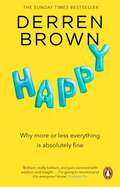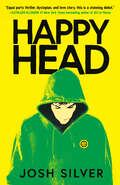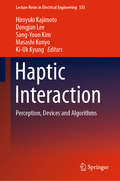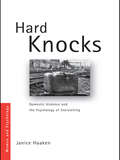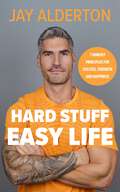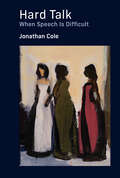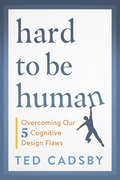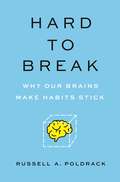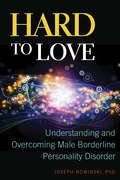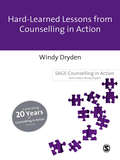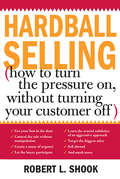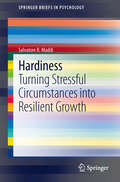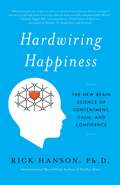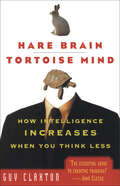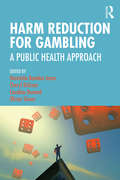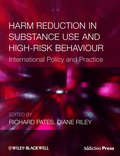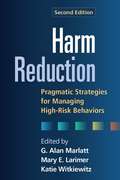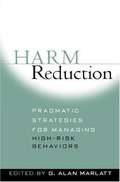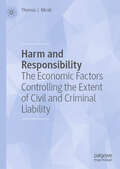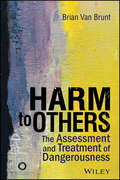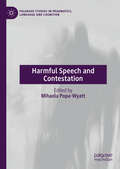- Table View
- List View
Happy-Aging statt Anti-Aging: Glücklich und sinnerfüllt alt werden
by Gerhard SpraktiesWie wird man glücklich und sinnerfüllt alt? In diesem Ratgeber erfahren Sie, wie Sinnfindung im Alter gelingen kann: Wie trägt Sinn zum Glücklichsein bei? Welche Rolle spielen Werte für die Sinnfindung im Alter? Wie können wir Sinnkrisen im Alter (wie z.B. Einsamkeit, Leiden, einer Demenzerkrankung oder Depression) begegnen, und welche positiven Sinnquellen lassen sich auch im höheren Alter noch finden?Der erfahrene Altenseelsorger und Logotherapeut Gerhard Sprakties zeigt Wege auf, die vom Trübsinn zum Sinn führen. Er beschreibt anhand von Beispielen aus der Praxis und mittels vielfältiger Happy-Aging-Tipps, wie trotz der sich im Alter häufenden Verlusterfahrungen und körperlich-seelischen Beeinträchtigungen ein glückliches und sinnerfülltes Leben möglich ist.
Happy: Why More or Less Everything is Absolutely Fine
by Derren BrownThe Sunday Times Bestseller'Really brilliant and just crammed with wisdom and insight. It will genuinely make a difference to me and the way I think about myself.' Stephen Fry___Everyone says they want to be happy. But that's much more easily said than done. What does being happy actually mean? And how do you even know when you feel it?In Happy Derren Brown explores changing concepts of happiness - from the surprisingly modern wisdom of the Stoics and Epicureans in classical times right up until today, when the self-help industry has attempted to claim happiness as its own. He shows how many of self-help's suggested routes to happiness and success - such as positive thinking, self-belief and setting goals - can be disastrous to follow and, indeed, actually cause anxiety.Happy aims to reclaim happiness and to enable us to appreciate the good things in life, in all their transient glory. By taking control of the stories we tell ourselves, by remembering that 'everything's fine' even when it might not feel that way, we can allow ourselves to flourish and to live more happily.___What readers are saying: ***** 'Immensely positive and life-affirming'***** 'This is the blue print to a good life'***** 'Thought provoking and potentially life-changing.'
HappyHead (HappyHead #1)
by Josh SilverA bold new dystopian thriller about an experimental mental health retreat center for young adults where everything is not what it seems—and one boy who will risk everything to escape.Seb has been selected for a new experimental mental health center called HappyHead, designed to solve the national crisis of teenage unhappiness. There he and fellow participants will complete in a series of assessments meant to test them, so they can better face the challenges of the real world. Seb is determined to win so he can change how people see him and make his parents proud. But then Seb meets a mysterious participant named Finn who has drawn unwanted attention to himself by resisting the program&’s rules. The leaders want everyone to believe Finn is mentally unstable but as Finn exposes cracks in the system around them, Seb is left questioning the true nature of the challenges--and wondering if Finn is actually the only one he can really trust. Something sinister is at play…and as the assessments take a dark turn, it becomes impossible to ignore the voice in his head telling him that even if he wins, there might be no way out.
Haptic Interaction: Perception, Devices and Algorithms (Lecture Notes in Electrical Engineering #535)
by Hiroyuki Kajimoto Ki-Uk Kyung Masashi Konyo Dongjun Lee Sang-Youn KimThis book constitutes the proceedings of the third international conference AsiaHaptics 2018, held in Songdo, Korea. It presents the state-of-the-art of the diverse haptics (touch)-related research, including perception and illusion, development of haptics devices, and applications to a wide variety of fields such as education, medicine, telecommunication, navigation and entertainment. This book is a valuable resource not only for active haptics researchers, but also for general readers wishing to understand the status quo in this interdisciplinary area of science and technology.
Hard Choices: How Women Decide about Work, Career, and Motherhood
by Kathleen GersonHow do women choose between work and family commitments? And what are the causes, limits, and consequences of the "subtle revolution" in women's choices over the 1960s and 1970s? To answer these questions, Kathleen Gerson analyzes the experiences of a carefully selected group of middle-class and working-class women who were young adults in the 1970s. Their informative life histories reveal the emerging social forces in American society that have led today's women to face several difficult choices.
Hard Knocks: Domestic Violence and the Psychology of Storytelling (Women and Psychology)
by Janice HaakenThis book draws on interviews carried out over a period of eight years, as well as novels, films, and domestic violence literature, to explain the role of storytelling in the history of the battered women’s movement. The author shows how cultural contexts shape how stories about domestic abuse get told, and offers critical tools for bringing psychology into discussions of group dynamics in the domestic violence field. The book enlists psychoanalytic-feminist theory to analyse storytelling practices and to re-visit four areas of tension in the movement where signs of battle fatigue have been most acute. These areas include the conflicts that emerge between the battered women’s movement and the state, the complex relationship between domestic violence and other social problems, and the question of whether woman battering is a special case that differs from other forms of social violence. The volume also looks at the tensions between groups of women within the movement, and how to address differences based on race, class or other dimensions of power. Finally, the book explores the contentious issue of how to acknowledge forms of female aggression while still preserving a gender analysis of intimate partner violence. In attending to narrative dynamics in the history of domestic violence work, Hard Knocks presents a radical re-reading of the contribution of psychology to feminist interventions and activism. The book is ideal reading for scholars, activists, advocates and policy planners involved in domestic violence, and is suitable for students of psychology, social work, sociology and criminology.
Hard Stuff, Easy Life: 7 Mindset Principles for Success, Strength and Happiness
by Jay AldertonIN A WORLD WHERE COMFORT AND CONVENIENCE OFTEN RULE, DISCOVER THE 7 MINDSET PRINCIPLES THAT ARE THE SECRET TO A FULFILLING LIFE ----EVERY TRANSFORMATION STARTS FROM THE NECK UPAre you tired of never getting what you want?Is convenience preventing you from achieving your goals?Do you crave an easier, more meaningful life?An ex-military and a transformation coach, Jay Alderton reveals the game-changing truth: the secret to an easy life is conquering the hard stuff, and the hard stuff is all in your head. Because every great transformation starts from the neck up, all you need to do is learn how to crack the mindset code to make the hard stuff very easy.By breaking down the seven key mindset principles for success, strength and happiness, Hard Stuff, Easy Life will equip you with the tools to overcome any obstacle . . . 1. Happiness Is an Inside Job2. Make Peace with Your Past3. Stay True to Yourself4. Get Over What Other People Think5. Focus on the Big Picture6. Embrace Obstacles7. Stay PresentOne of the most valuable and frequently overlooked lessons of all is that about staying present in the moment. This is how you not only build a life you want, but live it to the fullest, too.Whether you're aiming to conquer personal goals, get rich and successful, or thrive in your personal life, this book is your compass and guide towards what can be your easy life of fulfilment, abundance, and jaw-dropping achievements. It’s your new revolutionary guide that will transform your life, starting from the neck up.CRACK THE MINDSET CODE AND START LIVING YOUR BEST LIFE
Hard Talk: When Speech Is Difficult
by Jonathan ColeA moving, patient-centered portrait of the social importance of speech, from a medical expert known for his humanizing explorations of health.Language comes to us through culture, environment, and family. Words embed over time, as we use our minds to comprehend them and then our mouths to say, mean, and own them. Without the ability to speak, or when talking becomes difficult, we face a challenge like few others, forced to reconnect with a world that assumes its communicators are eloquent vocally. In Hard Talk, Jonathan Cole takes a necessary look at the privilege of speech so we can better accommodate those for whom it presents problems. Cole creates space for people with a variety of conditions, including cerebral palsy, vocal cord palsy, cleft palate, Parkinson&’s, and post-stroke aphasia, to describe in their own words what the experience of difficult speech is like. No struggle is the same. Each develops along its own axis of factors—cognitive, social, and physical—that lead to unique vulnerabilities as well as extraordinary moments of adaptation and resilience. One person finds social chatter becoming more problematic than work speech. Another grows alarmed as changes in speech begin to constrain inner thoughts. Some lose the ability to find or make words though they retain awareness, while others lose self-awareness but maintain fluent speech bereft of meaning. One even loses the ability to speak with family while continuing to interact at work.Hard Talk reacquaints us with the social power of speech while affirming the humane value of listening. Cole also reflects on the neuroscientific advances we&’ve made in understanding barriers to speech and how we might reduce them.
Hard to Be Human: Overcoming Our Five Cognitive Design Flaws
by Ted CadsbyPowerful strategies to combat the design flaws of the human brain that make life in the twenty-first century unreasonably difficult.If other animals could study us the way we study them, they would be puzzled by our unique ability to inflict misery on ourselves. We expend a lot of energy replaying past anguish, anticipating future distress, and stewing in self-righteous anger. Other animals would call us out for being oddly paradoxical creatures who long to be happy but who are the source of their own suffering, We worry about things we have no control over. We complain about not being understood while casting a critical eye on others. We stubbornly defend our beliefs despite contradictory evidence. Complicating all of this is our struggle to adapt to a complex world that we created. who struggle to adapt to a confusing world that we ourselves created.In our defence, we haven’t yet mastered our neuron-packed brains, whose incredible complexity evolved over millennia in a very different world than today’s. The result of this evolutionary journey? Five design features that often morph into design flaws in need of fixing.Hard to Be Human corrals the best insights from psychology, neuroscience, physics, and philosophy to reveal powerful strategies for the five big battles we each face in the war with our misguided, misbehaving selves. Tapping into deeply personal stories to ground the concepts in real life, Cadsby reveals how we can overcome our design flaws to be smarter, happier, and better adapted to the complexities of life in the twenty-first century.
Hard to Break: Why Our Brains Make Habits Stick
by Russell A. PoldrackThe neuroscience of why bad habits are so hard to break—and how evidence-based strategies can help us change our behavior more effectivelyWe all have habits we’d like to break, but for many of us it can be nearly impossible to do so. There is a good reason for this: the brain is a habit-building machine. In Hard to Break, leading neuroscientist Russell Poldrack provides an engaging and authoritative account of the science of how habits are built in the brain, why they are so hard to break, and how evidence-based strategies may help us change unwanted behaviors.Hard to Break offers a clear-eyed tour of what neuroscience tells us about habit change and debunks “easy fixes” that aren’t backed by science. It explains how dopamine is essential for building habits and how the battle between habits and intentional goal-directed behaviors reflects a competition between different brain systems. Along the way, we learn how cues trigger habits; why we should make rules, not decisions; how the stimuli of the modern world hijack the brain’s habit machinery and lead to drug abuse and other addictions; and how neuroscience may one day enable us to hack our habits. Shifting from the individual to society, the book also discusses the massive habit changes that will be needed to address the biggest challenges of our time.Moving beyond the hype to offer a deeper understanding of the biology of habits in the brain, Hard to Break reveals how we might be able to make the changes we desire—and why we should have greater empathy with ourselves and others who struggle to do so.
Hard to Love
by Joseph NowinskiBorderline Personality Disorder (BPD) in men is often misdiagnosed and typically leads to either no treatment or the wrong treatment. This is the first book to address this under-recognized problem. It contains symptoms and causes, as well as treatment, targeted to men who suffer from BPD.Joseph Nowinski, PhD, is a clinical psychologist in private practice and the author of numerous books. His most recent books include Saying Goodbye: A Guide to Coping with a Loved One's Terminal Illness and Almost Alcoholic: Is My (Or My Loved One's) Drinking a Problem?
Hard-Earned Lessons from Counselling in Action (Counselling in Action #15)
by Windy DrydenSeminars by Professor Windy Dryden. See the man live and in action. To find out more and to book your place go to www.cityminds.com ________________________________________ SAGE celebrated the 20th Anniversary of the Counselling in Action in November 2008. To view the video - click here ----------------------------------------------------------- `This is a very honest book and should be essential reading for anyone beginning training as a counsellor. It will also be useful for experienced therapists to stimulate reflections on their own practice... to examine their work and to learn from errors. It is refreshing to witness the honesty and openness of the writers - especially so in the present culture, where many therapists set themselves up as flawless experts... I would recommend this book... it provides an informed and open discussion on the problems encountered by therapists' - Clinical Psychology Forum Counsellors often struggle in their work with clients, convinced that their more experienced colleagues have not encountered similar problems and worries. In this volume, some of Britain's leading counsellors give the lie to this myth. Writing openly and frankly, they share the painful lessons they have learned over the course of their careers as practitioners. The contributors' combined experience proves that all counsellors, no matter how expert or well-known, have made mistakes, or faced challenges, and from them have had to learn aspects about the process of counselling - the hard way. The five `lessons' from each contributor are placed in the context of the counsellor's own particular circumstances, and a concluding section in each chapter links the connecting themes that emerged throughout their learning process.
Hardball Selling
by Robert ShookStraightforward secrets and strategies for salespeople who want to join the winning top 5 percent of the sales force Get your foot in the door Control the sale without manipulation Create a sense of urgency Let the buyer participate Learn the crucial subtleties of an aggressive approach Target the biggest sales Sell abroadAnd much moreFor many companies, 20 percent of their sales force generates 80 percent of their sales volume. In this hands-on guide, Robert L. Shook, a master salesman, teaches the high-pressure strategies that mean the difference between a super seller and a salesperson. The methods spelled out in this book describe what it takes to be in the elite 5 percent.In Hardball Selling, Shook inspires all salespeople to dare to be different and master hard selling without browbeating or offending customers. Shook spent 17 years in the trenches perfecting his successful strategies. Using the four basic principles of hardball selling, he guides you through all the steps, from getting past the "gatekeeper" to the single-minded tactics necessary to close a sale."Shook's Hardball Selling is provocative and controversial--and filled with wonderful selling tips. I highly recommend it to every salesperson."--Martin D. Shafiroff, the world's No. 1 stockbroker
Hardiness
by Salvatore R. MaddiThese are turbulent times in which it becomes increasingly important to survive and thrive despite stressful circumstances. Hardiness is the pattern of attitudes and skills that provides the courage and strategies that helps people be resilient by turning potential disasters into growth opportunities and fulfillment, thereby enhancing their performance, sense of fulfillment, and health. Hardiness as the pathway to resilience under stress has become of considerable interest, it is beginning to have an influence on the emerging emphasis of positive psychology by expanding this approach beyond mere happiness, to the courage and strategies needed to make the most of difficult times. The book starts with the special value of hardiness in being resilient by not only surviving, but also thriving under stress, and thereby achieving fulfillment in living. The book then elaborates on the pattern of attitudes and skills of hardiness that form the pathway to this needed resiliency. It discusses the 30 years of validational research and practice that is available concerning hardiness. The book offers various applications of hardiness assessment and training that can contribute to a better life. These include, among others, how hardiness can be trained in school and emphasized in psychotherapy, how hardiness facilitates the intimacy and longevity of relationships, and what organizations need in order to perform successfully in these turbulent times. The book is of interest to academics, industrial and organizational psychologists, clinical psychologists, mental health professionals, and professionals in public health, social work, sociology and human resources.
Hardwiring Happiness: The New Brain Science of Contentment, Calm, and Confidence
by Rick HansonWhy is it easier to ruminate over hurt feelings than it is to bask in the warmth of being appreciated? Because your brain evolved to learn quickly from bad experiences but slowly from the good ones. You can change this. Hardwiring Happiness lays out a simple method that uses the hidden power of everyday experiences to build new neural structures full of happiness, love, confidence, and peace. Dr. Hanson's four steps build strengths into your brain-- balancing its ancient negativity bias--making contentment and a powerful sense of resilience the new normal. In mere minutes each day, we can transform our brains into refuges and power centers of calm and happiness.From the Hardcover edition.
Hare Brain, Tortoise Mind: How Intelligence Increases When You Think Less
by Guy Claxton“Backs up anecdotal studies of creativity with up-to-date Information about the latest research into brain function . . . a fascinating book.” —Anthony Storr, author of Solitude: A Return to SelfIn these accelerated times, our decisive and businesslike ways of thinking are unprepared for ambiguity and paradox, and we’ve lost our appreciation for the value of “sleeping on it.” We assume that the quick-thinking hare brain will beat out the slower intuition of the tortoise mind. But new research in cognitive science is changing this understanding of human mental processes. It suggests that patience and confusion—not rigor and certainty—are the essential precursors of wisdom.With a compelling argument that the mind works best when we trust our unconscious, or “undermind,” psychologist Guy Claxton makes an appeal that we be less analytical and let our creativity have free rein. He also encourages reevaluation of society’s obsession with results-oriented thinking and problem-solving under pressure. Packed with interesting anecdotes, a dozen puzzles to test your reasoning, and the latest related research, Hare Brain, Tortoise Mind is an Illuminating, uplifting, stimulating read that focuses on a new kind of well-being and cognition.“The essential guide to creative thinking.” —John Cleese“His multidisciplinary approach is beautifully executed.” —Kirkus Reviews“Counterintuitive . . . provocative . . . While Claxton speaks the language of cognitive science, his ideas resonate with Freud’s description of the unconscious, Buddhist concepts of the divine ground of existence and the great Romantic poets’ notions of the fount of creativity.” —Publishers Weekly
Harm Reduction for Gambling: A Public Health Approach
by Henrietta Bowden-Jones Cheryl Dickson Caroline Dunand Olivier SimonThis edited volume aims to facilitate the evolution of the new public health approach towards gambling. Bringing together the work of international experts, it gives a current overview of the field, highlighting the need for a coordinated framework of prevention and harm reduction measures to replace current "player protection" measures. Chapters begin by exploring the impact of problem gambling, looking at its effects on several levels, ranging from the individual to the family and society. Subsequently an overview of prevention and harm reduction models is presented, bringing the reader to an in-depth understanding of what a public health approach to gambling would entail. Later chapters focus on potential challenges to monitoring and evaluation, inviting the reader to envisage possible barriers towards implementation and ways of overcoming these. The book concludes with recommendations on how to take a harm reduction approach, from a political and human rights perspective. This work gives a rare synopsis of the present-day issues when considering the implementation of a harm reduction strategy for gambling. Recent work by key professionals is presented in order to encourage further developments in this ever-changing domain. Such issues will be relevant to all those with an interest in the field of problem gambling, from clinicians, students and healthcare professionals, to politicians.
Harm Reduction in Substance Use and High-Risk Behaviour (Addiction Press)
by Richard Pates Diane RileyHarm Reduction is a philosophy of public health intended as a progressive alternative to the prohibition of certain potentially dangerous lifestyle choices. Recognising that certain people always have and always will engage in behaviours which carry risks, the aim of harm reduction is to mitigate the potential dangers and health risks associated with those behaviours. Harm Reduction in Substance Use and High-Risk Behaviour offers a comprehensive exploration of the policy, practice and evidence base of harm reduction. Starting with a history of harm reduction, the book addresses key ethical and legal issues central to the debates and developments in the field. It discusses the full range of psychoactive substances, behaviours and communities with chapters on injecting, dance drugs, stimulant use, tobacco harm reduction, alcohol use and sex work. Written by an international team of contributors, this text provides an essential panorama of harm reduction in the 21st century for educators and researchers in addiction and public health, postgraduate students and policy makers.
Harm Reduction, Second Edition
by G. Alan Marlatt Mary E. LarimerFrom addictions treatment pioneer G. Alan Marlatt and associates, this is the authoritative work on harm reduction: its principles, strategies, and practical applications. Contributors review programs that have been developed and tested for a range of high-risk behaviors, including problem drinking, tobacco use, illicit drug use, and risky sexual behavior. Flexible, tailored, culturally competent treatment approaches are described for marginalized and underserved communities. The volume also explores philosophical and policy-related debates surrounding this growing movement. New to This Edition, Reflects significant advances in research and clinical practice, as well as increasing professional acceptance of the harm reduction model.*Chapters on the current status of the field, applications to psychotherapy, and treatment of dual disorders. Chapters on additional populations (adolescent drinkers and Hispanic/Latino and Asian American substance users) and an additional substance (cannabis).
Harm Reduction: National and International Perspectives
by James A. Inciardi Dr Lana D. HarrisonIn this volume, international contributors discuss the philosophical basis and history of harm reduction policies and examine their outcomes. They also cover controversial topics related to harm reduction especially conflicts between the public health system, where most programs are located, and a worldwide criminal justice system that further marginalizes drug users. The book describes programs from the United States, the United Kingdom, Canada, Brazil, The Netherlands, Switzerland and Australia.
Harm Reduction: Pragmatic Strategies for Managing High-Risk Behaviors
by G. Alan MarlattHarm reduction principles and strategies are designed to minimize the destructive consequences of illicit drug use and other behaviors that may pose serious health risks. The first major harm reduction text, this provocative and timely volume examines a wide range of current applications, from needle exchange and methadone maintenance programs, to alternative alcohol interventions and HIV/AIDS prevention campaigns. Insight is also offered into the often contentious philosophical and policy-related debates surrounding this growing movement.
Harm and Responsibility: The Economic Factors Controlling the Extent of Civil and Criminal Liability
by Thomas J. MiceliRisk is an ever-present feature of life in a complex world, and it is important for societies to manage it in a just and efficient manner. One way to reduce risk is to assign responsibility for the associated harm. In this book, economist Thomas J. Miceli examines harm and responsibility from an economic perspective. The book focuses on how responsibility affects people’s incentives to refrain from causing unnecessary harm to achieve what economists call optimal deterrence. Secondarily, it is concerned with the quest for justice. Defining this is part of the journey. Does it mean compensating victims for unavoidable losses? Does it involve punishing wrongdoers in proportion to the harm they have caused? Is there a clear answer? The book addresses these questions and more, explaining how, in some cases, these objectives will align with deterrence and in others they will not. The book discusses the ways that the law, tempered by religious and social norms, strikes a balance between these goals. The principal areas of law that assign legal responsibility are tort law (for accidental harms) and criminal law (for intentional harms). There exist vibrant economic theories of both, and this volume draws on this literature. One theme that emerges is the role of causation in determining responsibility. Attributing responsibility for a given harm to the party that caused it seems both morally just (because it embodies personal responsibility), and economically desirable (because it achieves deterrence in the most direct manner). And yet the law departs from this prescription in any number of ways, both by limiting the responsibility of some who caused harm and by expanding responsibility to some who did not. The book offers readers coherent economic explanations for these departures from a purely causal basis for legal responsibility. Author Thomas J. Miceli clarifies causation as reciprocal in nature and therefore not a uniquely defined concept. This means that when an action by A causes harm to B, the question is not how to restrain A but rather: whether A has the legal right to take the action in question or whether B has the right to prevent it. There will be a harm either way; the relevant question is which party should bear it. This insight ultimately leads to the fundamental problem of defining harm. In most conflicts this can be straightforward—as when A punches B—but in others it is more challenging. For example, when does free speech become hate speech? Where is the line drawn? The book concludes by drawing out the implications of this fundamental ambiguity over the meaning of harm, what that means for the law, and what economic theory has to say about it.
Harm to Others: The Assessment and Treatment of Dangerousness
by Brian Van BruntHarm to Others offers students and clinicians an effective way to increase their knowledge of and training in violence risk and threat assessment, and it also provides a comprehensive examination of current treatment approaches. Although the text includes many examples from K–12 and college/university settings, which are particularly relevant for mental health professionals in school settings, the underlying concepts and suggestions are useful for counselors, psychologists, and social workers who face these issues in their daily practice. In an easy-to-understand, jargon-free manner, Dr. Van Brunt shares his observations, extensive clinical expertise, and the latest research on what clinicians should be aware of when performing risk and threat assessments. In addition, he offers numerous examples from recent mass shootings and rampage violence to help explain the motivations and risk factors of those who make threats. Two detailed case examples are presented to illustrate key concepts related to assessing dangerousness. Treatment options are then described, using a variety of diverse case studies to demonstrate concrete approaches for clients who have been identified as at risk for violence following a threat assessment. *Requests for digital versions from the ACA can be found on wiley.com. *To request print copies, please visit the ACA website here. *Reproduction requests for material from books published by ACA should be directed to permissions@counseling.org.
Harmful Speech and Contestation (Palgrave Studies in Pragmatics, Language and Cognition)
by Mihaela Popa-WyattThis edited book explores how harmful speech works, how it can be used to change societies in bad ways and how we can defend against it. Harmful speech comes in a variety of forms, including hate speech, dehumanizing speech, misogynistic speech, derogatory speech, misgendering, marginalizing speech, and much more. What is common to all these types of speech is that they don’t just offend but seek to harm members of vulnerable groups, so that they feel humiliated, attacked, denigrated, silenced, and dehumanised. These harms are not confined to the conversation in which such speech is used, but may involve various downstream effects such as moral, social, and epistemic harms. Harmful speech may also shift social norms by changing people’s opinions and ultimately changing norms about how targets ought to be treated. Harmful speech uses this effect to establish and maintain oppressive norms, entrench hierarchies and shape power relations. The contributions in this volume examine the mechanisms underlying various forms of harmful speech and possible responses and remedies. They combine a variety of tools and perspectives, including philosophy of language, linguistics, ethnography, with a particular focus on issues in the semantics/pragmatics of derogatory expressions, speech acts and conversational dynamics. The chapters bring these conversations together and highlight the ways in which philosophers of language have sought to build bridges in recent years with social and political philosophy concerned with the nature of oppression and responses to it. These topics offer the opportunity for a valuable integration of insights from different perspectives.
Harmony, Perspective, and Triadic Cognition
by Norman D. CookThe big question in the science of psychology is: Why is human cognition and behavior so different from the capabilities of every other animal species on Earth - including our close genetic relations, the chimpanzees? This book provides a coherent answer by examining those aspects of the human brain that have made triadic forms of perception and cognition possible. Mechanisms of dyadic association sufficiently explain animal perception, cognition, and behavior but a three-way associational mechanism is required to explain the human talents for language, tool-making, harmony perception, pictorial depth perception, and the joint attention that underlies all forms of social cooperation.

